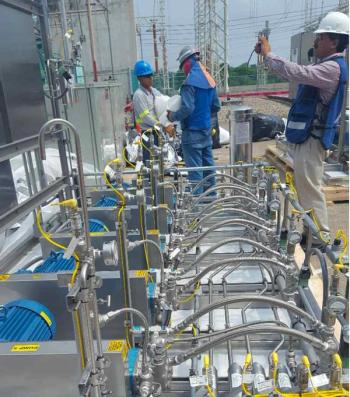
Rolls Tidal
Rolls-Royce aims to be one of the leading OEMs in a market where there is potential to generate more than 20GW of electricity worldwide. There is currently no commercial tidal stream energy industry and how it evolves and develops will depend on the actions of technology leaders and governments.
Tidal forces are produced by the moon and the sun in combination with the earth’s rotation. The tides that result are predictable for many years into the future. Tidal power comes in two forms: tidal range, which exploits thesize of tides; and tidal stream, which uses the speed of tidal currents.
Water is 800 times denser than air, which gives it huge potential for power extraction. Tidal generators cannot be seen or heard from the shore. Tidal stream generation represents an enormous opportunity, with between 20GW - 30GW available globally.
The Rolls Royce 1MW tidal stream generator features a speed, high-torque gearbox, pitching composite blades, autonomous operation and remote control, modular construction for easy maintenance and repair.
The challenge for the emerging tidal stream power generation industry over the next decade is to increase the scale, prove the reliability, demonstrate environmental acceptability and reduce the costs of the technology to ensure electricity can be generated at a commercially competitive price.
One key to meeting this challenge is the rapid deployment and retrieval system created by Rolls-Royce. It allows the turbine to be installed or uninstalled in just 20 minutes, maximising the time it spends producing electricity and minimising the cost of deployment and maintenance to its operator. This is achieved by making the turbine buoyant. It can be towed to its point of operation.
On site, it uses a patented winch and clamp design that winches the nacelle down to its seabed support structure and locks it in place. Simple and efficient, the system avoids the need for specialist highcapacity lift vessels and for divers.
Another major competitive advantage stems from the way the system yaws. Tidal streams do not always turn through 180 degrees. As the tide turns, four times each day, the turbine turns with it, positioning itself to face directly into the flow at the optimum angle to extract the maximum energy potential. At the same time it withstands the powerful forces the flows exert on the structure.
Rolls-Royce began trials of a 500kW tidal stream turbine in 2010 and during initial trials produced over 50MWh of electrical power in total, averaging 12 hours of operation each day, demonstrating extended running at base load. Development of a 1MW tidal stream generator began in October 2010 and manufacture is now under way in readiness for a two year test programme. Experience gained will benefit a 10MW demonstration array scheduled for 2013/14.
Main features: The project’s key features include:
A three-bladed rotor operating at 14 rpm coupled to an epicyclic gearbox to increase the speed, then to an induction generator and power converter
Rotor diameter 18m
Turbine length 21m
Service life of 30 years with minor maintenance every 2 years
Turbine weight: 135 tonnes (not including seabed support structure)
Turbine width: 2.6m to 3.5m
Turbine height: 5m
Installed water depth 35m to 80m
Water speed at rated power: 2.7m/s
Cut-in velocity: 1m/s
Maximum operating water speed: 3.4m/s
Power exported via subsea cable to grid at 6.6kV
Working with turbines at low-speed, at high torque and at sea are all areas in which Rolls-Royce has extensive expertise through its substantial marine business. A key part of the turbine’s power driver is core Rolls-Royce technology that draws on the company’s powerful experience in marine propulsion and motion control systems.
For optimum efficiency, tidal stream generators need to be placed in powerful marine currents. These occur where water, being moved by tidal forces, encounters a restriction such as a narrow passage between two land masses. Some of the most promising sites are found around the western coastline of the British Isles, where Rolls-Royce will locate its 1MW tidal stream demonstrator.
Particularly interesting sites for further investigation also exist off Canada, South America, Western Europe and South Korea. The entry into this marketplace of highly experienced and influential companies such as Rolls-Royce is essential to give governments and potential operators of tidal arrays the knowledge and confidence to support the technology’s commercial potential. Work now underway at Rolls-Royce will demonstrate the extent to which technologies can successfully be evolved, developed and adapted to create tidal stream generators.
Newsletter
Power your knowledge with the latest in turbine technology, engineering advances, and energy solutions—subscribe to Turbomachinery International today.





